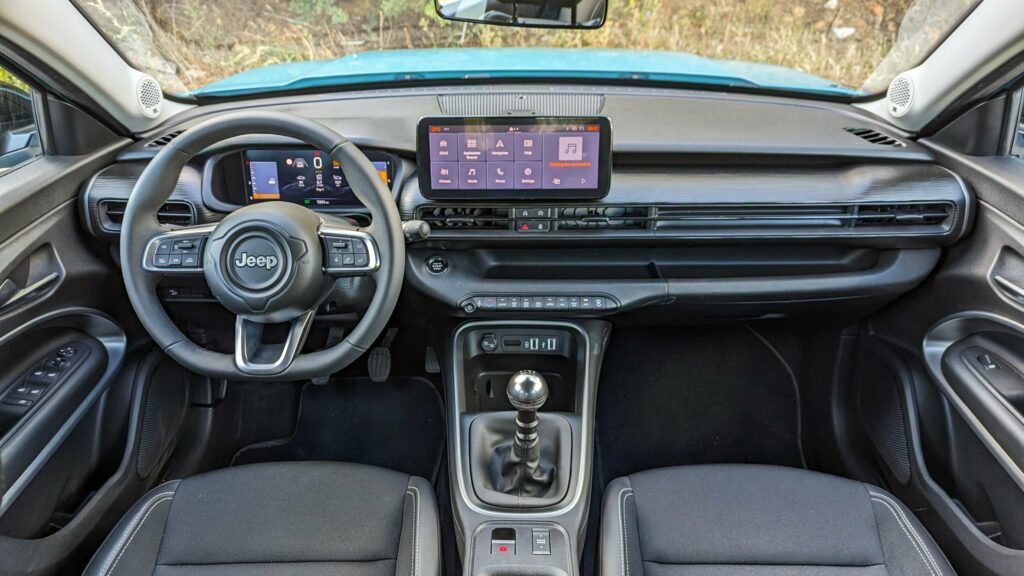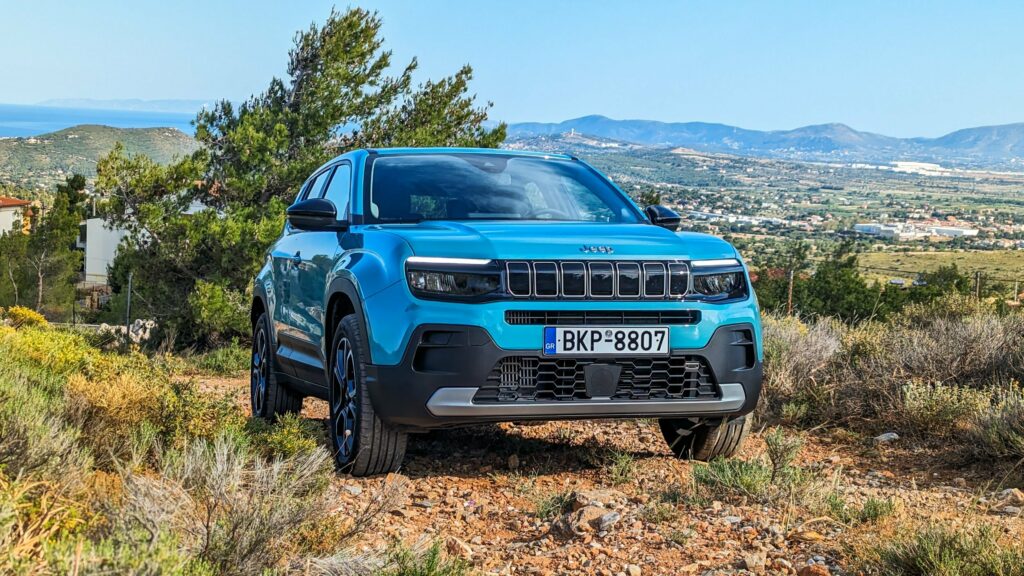When it came out in 2022, the Jeep Avenger was the brand’s first electric car. But soon after, the company added versions with small hybridization and internal combustion engines (ICE). A short time ago, we went for a test drive in the regular Avenger, which has a 1.2-liter gasoline engine and a manual gearbox. We wanted to see how well this mix meets the needs of living in an urban SUV.
Modern design with useful rooms inside
The Avenger looks great even though it’s a small SUV. Its sleek, modern take on Jeep’s design language draws attention to its sporty proportions and strong frame. Entry-level cars with small wheels and LED headlights might not stand out, but the bright Lake Green color and 18-inch wheels on our press car make it stand out.
The electric and gasoline-powered Avengers look a little different. The change that stands out the most is the addition of a tailpipe in the back. This exhaust has a wide, triangular shape and comes out of a hole in the aluminum-style skid plate. The gas-powered version also doesn’t have an “e” badge on the taillight and keeps the mostly blocked seven-slot grille for better airflow.

The inside of the Avenger is simple, but it works well. Even though most surfaces are made of hard plastic, they last a long time and don’t break easily. The focus is on usefulness, and the technology looks like it’s up to date. The standard 10.25-inch touchscreen for entertainment is quick and has wireless connectivity, which is important for current technology.
Adding more ways to customize the 10.25-inch digital instrument panel would make driving even more enjoyable.
With a length of 4,084 millimeters (160.8 inches), the Avenger is a useful subcompact SUV. Between 146 millimeters (5.7 inches) and 336 millimeters (13.2 inches), it is much smaller than both the Renegade and the Compass. The Avenger isn’t very big, but its boxy shape and smart packing inside make it possible for four people to sit comfortably on shorter trips, and the 380-liter (13.4 cubic feet) storage space is big enough to hold daily necessities.
There is a lot of storage space inside, but because it has a manual transmission, the big center console box that is common in EVs had to be taken out. Instead, there is a small wireless charge port under the two USB ports.
Going back to the basic configuration
Jeep thought that electric cars would take over the market, so they first only sold the Avenger with an internal combustion engine (ICE) in a few European countries. However, the company changed its strategy and put more emphasis on ICE and hybrid engine options because demand for EVs has slowed down around the world.
The Avenger’s turbocharged 1.2-liter three-cylinder engine comes standard in all small and compact Stellantis brands, such as Fiat, Citroen, DS, Opel, and Peugeot. The latest version of it has 99 horsepower (74 kW / 100 PS) and 205 Nm (151.2 lb-ft) of torque, which is 55 horsepower (41 kW / 56 PS) and 55 Nm (41 lb-ft) less than the electric car.
The engine that doesn’t use electricity can only be bought with a six-speed manual transmission, and the mild hybrid can only be bought with a six-speed dual-clutch automatic transmission. All versions of the Jeep Avenger get power to the front wheels, except for the top-of-the-line mild-hybrid 4xe.
The engine could power the Avenger’s small frame, even though it only had a few horsepower. It was especially useful in the middle. The electric model weighs 354 kg more than the ICE model, which is only 1,182 kg (2,606 lbs). The manual transmission is well-tuned, and the torque output is good enough for normal driving, even though the acceleration isn’t great.
When compared to bigger Stellantis cars with the same motor and better insulation, the engine gets noisier and loses torque as RPM goes up. The gasoline-powered Avenger, on the other hand, can go much faster than the electric one. This makes it a good driver for its size as long as you don’t push it too hard.
When the small engine is working hard, it may drink a lot of oil, which makes the factory’s predictions of how much it would use seem unrealistic. From what we’ve seen, the average amount of fuel used in mixed conditions is between 7.5 and 8.0 lt/100 km (29 and 31 mpg) unless the driver is very calm and has a light right foot.
Another interesting thing about the ICE-powered Avenger is that it has a range of 580 km (360 miles) on a full tank of gas, which is a lot more than the EV’s WLTP rate of 400 km (248 miles).
The Avenger’s suspension system is still one of its best features. It’s only found in Jeeps and makes the ride smoother and more fun than in other cars in its class. But the little Jeep is easy to drive; it has a good grip and doesn’t roll around much when turning. The lighter, gas-guzzling Avenger is easy to stop with the brakes, even though they have a slightly smaller brake width than the heavier EV.
Even though it has front-wheel drive (FWD), the Avenger handles rough territory very well. The 201 mm (7.9 inch) ground clearance and small overhangs make good approach and departure angles possible, which gives the driver more confidence.
The front-wheel drive system might make off-roading harder, but the six basic Selec-Terrain drive modes (Eco, Normal, Sport, Sand, Mud, and Snow) help a bit. These modes change the computer settings to make the tires grip better when it’s wet. They do, however, have a bigger effect on how the car drives than they do on the electric Avenger, where they change the engine output in a big way.
Finally, the Avenger is more active than most competing subcompact SUVs. However, the mild-hybrid 4xe with better tires and the ability to go off-road more often would be a better choice for people who plan to do that.
Price and Gear
The Jeep Avenger 1.2’s base model costs €24,267, which is about $26,346, while the Altitude model, which has more features, costs €26,267, which is about $28,519. We tested the Altitude model in Greece. This means that it costs €14,710 ($15,970) less than the EV and €2,500 ($2,714) less than the similar mild hybrid before any government incentives are taken into account.
The base Longitude model has 16-inch wheels and halogen headlights. It also includes a six-speaker music system, a 10.1-inch tablet, and rear parking sensors. The mid-level Altitude model has adaptive cruise control, a 10-inch digital instrument panel, and 17-inch wheels.
The €1,893 ($2,055) package comes with stylish 18-inch wheels, ambient lighting inside, and full-LED lamps in the shape of an X. For an extra €1,559 ($1,693), you can get an option with a hands-free tailgate, a wireless charging pad, built-in navigation, and a JBL music system.
Most of the above features come standard on the top-of-the-line Summit trim, which is only available on the electric Avenger in this market.
In conclusion
The Jeep Avenger with an internal combustion engine (ICE) still has that cool vibe, even though it starts at a lower price and is easier to fill up. The well-tuned six-speed manual gearbox and turbocharged 1.2-liter engine give it enough power for most uses, though quick acceleration can be loud and use a lot of gas.
The Avenger has a very smooth ride for a car in its class, and the cabin is bigger than you’d think for an SUV that is 4,084 mm (160.8 inches) long. This is because the suspension tune is made just for Jeeps.
If you have more money to spend, you might choose the mild-hybrid version of the same engine because it is more technically advanced, even though the ICE mix is a good deal. With this choice, you could save money on gas and enjoy the ease of an automatic gear. Last but not least, the Jeep Avenger 4Xe mild hybrid with all-wheel drive looks like the best type of car, but we think it will cost a lot more.

COMMENTS